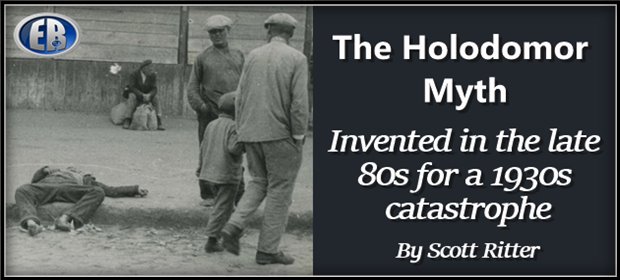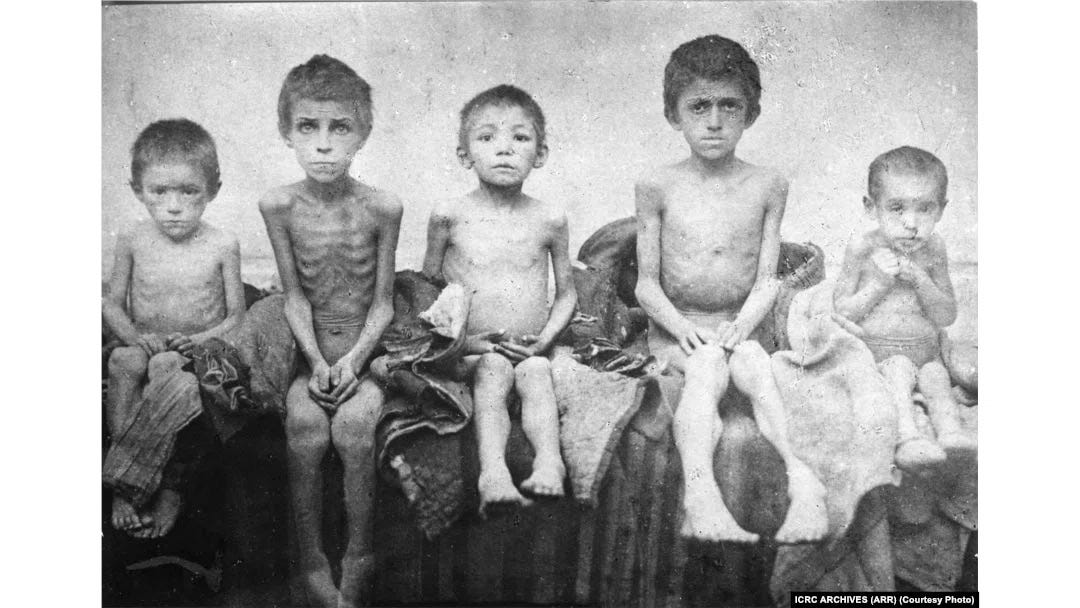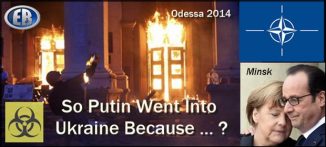
ER Editor: Kudos to Scott Ritter for appealing to the research trail that sets this Russophobic myth straight. It’s interesting how Google supports the myth in its first search results. By now, biased online search results should set the alarm bells ringing.
********
The Holodomor Myth

On December 2 of this year, I was in Ann Arbor, Michigan, on day two of a three-day “residence” sponsored by the Ann Arbor Coalition Against War. The first day, December 1, saw a wonderful event the organizers called “Pubology,”set in the upstairs bar of the Original Cottage Inn. It was standing room only, with a very engaged crowd who had lots (and lots!) of outstanding questions.
The next day, December 2, found me in the Journey of Faith Church, with a very respectable crowd. I arrived early, and was standing to the side, collecting my thoughts (it is my goal to provide a unique talk every time I do public speaking, so I was trying to line up some chronologically consistent talking points that I could string together to make an hour-long presentation.)
I did a quick survey of the room when I entered (an old habit dating back to my prior life) and was immediately drawn to a middle-aged man seated in the chairs that had been set out for the attendees. Most of the time when I come early to events like this, the people who are already seated at least make eye contact and smile. This guy didn’t. Instead, he was focused on a stack of flyers he held in his hand, and when he did lift his gaze, the look was not welcoming.
I don’t take being on the Ukrainian government-sponsored “Black List” (published by the Center for Countering Disinformation, part of the Office of the President) lightly. To be labeled a Russian propogandist and an information terrorist who should be arrested and tried as a war criminal is no laughing matter. The same can be said for the “Myrotvorets” (Peacemakers) hit list promulgated by the Ukrainian SBU (intelligence service). It is—literally—a death list, with those on it marked for “liquidation” at the hands of the Ukrainian secret services.
In short, between these two lists, I had a giant target painted on my back, one that was largely funded by my own government for the purpose of suppressing my constitutional right of free speech. Moreover, here in the United States the odious ideology of Stepan Bandera is actively fostered and promoted, manifesting itself in “Heroes Parks,” where the busts of Bandera and his Nazi colleagues are openly displayed and admired, to the halls of the US Congress, where lawmakers who once rightfully insisted US taxpayer dollars be prohibited from being used to train and equip Banderist organizations like the Azov Battalion, described by Congress as a White Supremacist Neo-Nazi terrorist organization, but now openly welcome senior Azov members into the People’s House, where they are feted and praised by Congressional hypocrites.
In this day and age of political violence, one doesn’t have to work too hard to come up with a scenario where a Banderist true believer imagines that an official green light has been given to act out and liquidate someone the US government has labeled an “information terrorist.”
This was on my mind as one of the event coordinators escorted this very same man up to where I was standing. He was wearing an overcoat which hid much of his torso and hips from view, and his arms remained folded across his chest, holding papers and who knew what else. The organizer handed me a piece of paper—one of the flyers the man was holding—and said he had some questions for me.
The top of the flyer was emblazoned with the word “Holodomor,” with a subtitle declaring “Forced Genocidal Starvation of Ukrainians by Soviet Union 1932-33.” The font colors were red and black—blood and soil, the colors of Bandera.
At the bottom of the page were the words “Slava Ukraini”—Glory to Ukraine, the Bandera salute.
My alarms were going off. I did a quick scan of the room, which was rapidly filling with people coming for the talk. None appeared to be in position to support this guy, but that could change in an instant. I took a step toward the man in the greatcoat, crowding him, thereby making it more difficult for him to unfold his arms, all the while staring into his eyes, looking for some indication of intent.
I saw fear and anger.
Scott Ritter will discuss this article, and answer audience questions, on Episode 30 Thursday.
“Are you familiar with the Holodomor?” he asked in an aggressive tone.
“I am,” I answered, still staring at him. “I read Robert Conquest’s The Harvest of Sorrow [the first definitive study of the famine of 1932-33 that swept through the Soviet Union, including Ukraine, killing millions] when it first was published back in the 80’s.”
“So you know about the genocide of the Ukrainian people,” the man said.
“I know of a human tragedy that befell millions of Soviet citizens in Ukraine, Belorussia, Russia, and Kazakhstan,” I replied.
“You’re a Russian propagandist!” the man exclaimed.
I had had enough. This guy was giving off all the signals of someone looking for trouble. I took a half step forward, crowding him some more. If he was hiding a knife or some other weapon, I’d be able to neutralize him before he could attack me.
“Fuck off,” I said, firmly, shocking him and my host. “Who the fuck do you think you are coming in here and addressing me like this?”
The man became very indignant. “Fuck off? What kind of event is this? Fuck off?”
I shuffled closer, staring at him.
“What, are you going to punch me?” he asked.
“No,” I replied. The correct answer was headbutt, followed by a knee to the solar plexus, followed by a head stomp.
If it got to that.
He stared back. “So now we are in a staring contest?” he asked.
I remained silent.
“You are a Marine,” he said. “You want to kill me!”
You have no idea, I thought.
The host quickly intervened, separating us. She tried to calm the man down, all the while looking perturbed. I took a step back, still focused on his hands, all the while scanning the room for any potential collaborators.
It was becoming clear this guy wasn’t an assassin, but rather someone out to pick a fight over Ukraine.
“What do you know about the Holodomor?” I asked.
“I know it was a genocide perpetrated by Stalin. One that is being continued today by Putin.”
I laughed. “Are you an academic? A Russian studies expert?” I questioned.
“I am a political scientist.”
“Do you speak Russian? Have you done the research into this topic yourself?” I queried.
“I spent five weeks in Ukraine.”
“When did you get back?” I probed.
“Last week.”
“So let me get this straight,” I concluded. “You spent five weeks in Ukraine. That’s the extent of your expertise. And now you want to engage me in some sort of debate on the issue of the Holodomor? Get the fuck out of here.”
By this time the host had brought over some help, and the man in the greatcoat was ushered back to his seat, all the while complaining about me to everyone in the crowd.
The event proceeded, and by all accounts was a success. The man in the greatcoat was given an opportunity to ask questions, which he did. Clearly my answers did not meet with his approval, given that he loudly proclaimed me to be a puppet of Russian President Vladimir Putin. He then got up to leave, the task of disrupting the event complete.
Afterwards, I grabbed one of the flyers he had been distributing amongst the attendees. After reading the text, it was clear this man was part of a broader political effort designed to use the narrative of the Holodomor as a vehicle to denigrate Russia and to promote Ukrainian nationalism.
“It is time,” the flyer declared, “to acknowledge that the current war in Ukraine is an extension of the genocidal policies of the Russian state. Such policies were a tactic of the USSR and continue to be so as directed by Vladimir Putin, in an effort to extend Russian rule over non-Russian republics of the now defunct Soviet Union.”
“It is time,” the flyer continued, “to reject Vladimir Putin’s claim that Ukrainians and Russians are ‘one people’ as a precursor to and defense for this War.”
“It is time,” the flyer concluded, “to teach the Holodomor as genocide in Michigan Public Schools.”
I was struck by the photograph the man opted to use to illustrate his flyer—five gaunt boys, clearly starving. Most students of Russian history, however, would recognize the photo as being from the famine of 1920-21, which had nothing to do with the period encompassed by the so-called Holodomor.
Hopefully, that little error would be corrected before finalizing any curriculum.
“The famine of 1932-33,” the flyer noted, “is often called the Holodomor, a term derived from the Ukrainian words for hunger (holod) and extermination (mor).”
What the flyer failed to point out is that the term Holodomor came into being only in the late 1980’s, conjured up by Ukrainian nationalists trying to fan the flames of Ukrainian independence from the Soviet Union in its final years, in short, a fake word used to define a fake narrative.
The famine that swept through the Soviet Union in 1932-33 was very real—there is no denying this. But it was not an isolated event, but rather part and parcel of the Stalin-driven policy of forced collectivization of agriculture. During the period of forced collectivization between 1930-37, Robert Conquest estimated that some 14.5 million peasants lost their lives; of these, some 5 million were Ukrainians who died during the famine of 1932-33.
These are horrible numbers, reflective of human tragedy and suffering of an unimaginable scale. Robert Conquest’s groundbreaking work, The Harvest of Sorrow, has served as one of the primary sources behind the resurgence of Ukrainian nationalism in the late 1980’s. Indeed, as Conquest himself concluded, “Stalin…saw the [Ukrainian] peasantry as the bulwark of nationalism; and common sense requires us to see this double blow at Ukrainian nationhood as no coincidence.”
But even Conquest had to admit that this conclusion was pure speculation on his part. “As to Stalin’s personal guilt,” Conquest wrote, “we cannot document the responsibility in the sense of any decree exists in which Stalin orders the famine.”
Conquest concluded that, from his standpoint, “the facts are established; the motives are consistent with all that is known of Stalinist attitudes; and the verdict of history cannot be other than one of criminal responsibility.”
This is the narrative that the Ukrainian nationalists use to sustain their argument that the Holodomor was a targeted act of genocide carried out by Stalin against the Ukrainian people.
The problem is, the historical record does not support such a conclusion. After the fall of the Soviet Union, the Soviet archives were opened to western scholars, who were able for the first time to draw upon primary sources of information to critically examine the Cold War-era historical narrative, such as the one promulgated by Conquest in The Harvest of Sorrow. Conquest’s conclusions were found wanting—there simply was no documentary evidence to back up his claims that Stalin was criminally responsible for the targeted starvation of the Ukrainian people in 1932-33.
When confronted by two of these scholars, R. W. Davies and Stephan G. Wheatcroft, Conquest was compelled to agree that his conclusion that Stalin purposefully inflicted the 1932-33 famine was wrong. With the benefit of this new research, Conquest instead argued that Stalin “could have prevented it [the famine] but put ‘Soviet interest’ other than feeding the starving first—thus consciously abetting it.”
No Holodomor, no genocide, but rather a narrative of a society undergoing revolutionary transformations (i.e., forced agricultural collectivization) which its leadership was unable to effectively manage, leading to great human tragedy.
But the forces of modern Ukrainian nationalism needed to manufacture a case for dividing Ukraine into eastern (pro-Russia) and western (anti-Russia) blocs, and in 2006, the Ukrainian Parliament passed a bill which labeled the 1932-33 famine an “act of genocide against the Ukrainian nation,” ignoring the reality that both ethnic Russians and Ukrainians died by the millions during the famine, and that there was no documentary evidence that Stalin either orchestrated the famine or used it to target the Ukrainian population.
The bill was backed by then-President Viktor Yushchenko, the same man who, four years later, would pressure the Ukrainian Parliament to pass a bill awarding the title “Hero of Ukraine” to Stepan Bandera.
The reality is that far from representing the historical continuity of a nefarious Russian scheme that has targeted the Ukrainian people for genocidal eradication, the Holodomor “myth” has been used by Ukrainian nationalists to criminalize Russia and, by extension, Russians—and their current leader, Vladimir Putin, all the while extolling the odious ideology of one of history’s most vile characters—Stepan Bandera.
This mindset was on full display in the flyer distributed by the man in the greatcoat in Ann Arbor, Michigan, on the night of December 2. “For Vladimir Putin,” the flyer read, “in 2022 to claim that Russians and Ukrainians are ‘historical brothers’ is a lie. It ignores the history of the Holodomor. No living being would treat his brother with such violence and contempt.”
But like everything associated with modern-day Ukrainian nationalism, the narrative of the Holodomor is built on a foundation of lies designed to promote the violent separation of Ukraine from Russia. This trajectory became evident in the violent accession of the followers of Stepan Bandera during the Maidan coup in February 2014, their subsequent murderous rampage in Odessa, Mariupol, and the Donbas, the eight years of incessant bombardment of the civilian population centers of the pro-Moscow separatists, the lies of the Minsk Accords, and the preparations for war against Russia that preceded the initiation of the Russian Special Military Operation.
The Holodomor myth is used to promote genocidal polices. These policies, however, are not the manufactured linkage between Stalin and Putin when it comes to Ukraine and its people that is currently being promoted by the Ukrainian government, but rather reflective of a cultural genocide being conducted by Ukraine and its western supporters against Russia, targeting the Russian language, history, culture, religion, and lives of the ethnic Russians living in eastern Ukraine.
The Holodomor is part of the foundation upon which the entire shaky edifice of Ukrainian nationalistic resistance against Russia today is built. It is responsible for the tragedy befalling the people of Ukraine today—the dissection of their territory, the destruction of their economy, and the slaughter of their men on the battlefield. It is a lie that serves as the source of the pain and suffering of all of Ukraine.
************
Source

••••
The Liberty Beacon Project is now expanding at a near exponential rate, and for this we are grateful and excited! But we must also be practical. For 7 years we have not asked for any donations, and have built this project with our own funds as we grew. We are now experiencing ever increasing growing pains due to the large number of websites and projects we represent. So we have just installed donation buttons on our websites and ask that you consider this when you visit them. Nothing is too small. We thank you for all your support and your considerations … (TLB)
••••
Comment Policy: As a privately owned web site, we reserve the right to remove comments that contain spam, advertising, vulgarity, threats of violence, racism, or personal/abusive attacks on other users. This also applies to trolling, the use of more than one alias, or just intentional mischief. Enforcement of this policy is at the discretion of this websites administrators. Repeat offenders may be blocked or permanently banned without prior warning.
••••
Disclaimer: TLB websites contain copyrighted material the use of which has not always been specifically authorized by the copyright owner. We are making such material available to our readers under the provisions of “fair use” in an effort to advance a better understanding of political, health, economic and social issues. The material on this site is distributed without profit to those who have expressed a prior interest in receiving it for research and educational purposes. If you wish to use copyrighted material for purposes other than “fair use” you must request permission from the copyright owner.
••••
Disclaimer: The information and opinions shared are for informational purposes only including, but not limited to, text, graphics, images and other material are not intended as medical advice or instruction. Nothing mentioned is intended to be a substitute for professional medical advice, diagnosis or treatment.





Leave a Reply